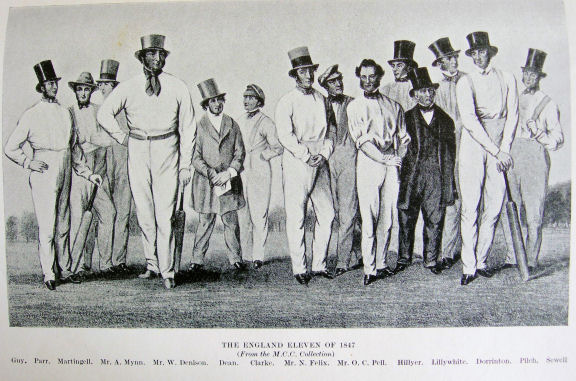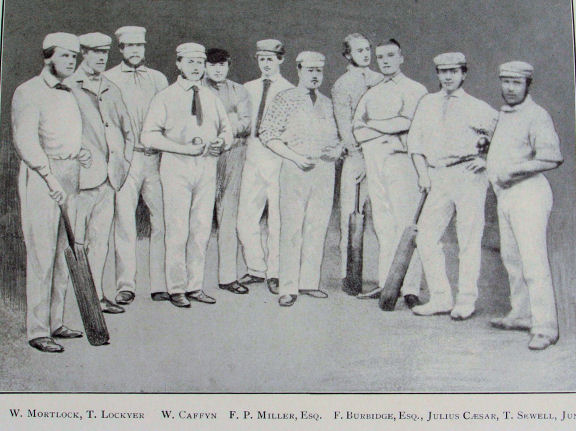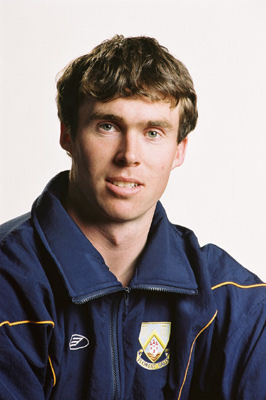

Well Hit Sir, Part 2
by John Saul
This article was originally published in the August 2006 edition of Soul Search, the journal of The Sole Society
Further information about Tom Sewell father and son has come to light since my initial article, and thanks to member Edna Pritchard my attention has been drawn to another Mitcham-born cricketing Sewell, her X2 great-grandfather William Humphrey, the younger brother of Tom senior. As recorded in the Sewell Coordinator’s report in Soul Search vol 3 no 4, we now know that the Mitcham Sewells were primarily calico printers by trade, but playing cricket professionally would have produced significant additional income.
 Tom Sewell Snr, born 1806, was a member of the All-England Eleven of 1847, a
‘sound batsman’, and I have found a copy of a print of the team in which he
stands at the extreme right (Fig 1). This team was not quite what it sounds as
there was no international cricket in those days, but they did represent the
cream of cricket in England, and were the very first group of professional
cricketers to be organised and maintained in the field for a series of matches.
They were the focus of attention wherever they went, and it was every local
cricketer’s ambition to perform well against them. They played up to 30 matches
a season, always against odds, e.g All England versus 22 of Bishop’s Stortford,
and much of their travelling was to places not yet reached by the railways. For
this the players were paid between £4 and £6 per match.
Tom Sewell Snr, born 1806, was a member of the All-England Eleven of 1847, a
‘sound batsman’, and I have found a copy of a print of the team in which he
stands at the extreme right (Fig 1). This team was not quite what it sounds as
there was no international cricket in those days, but they did represent the
cream of cricket in England, and were the very first group of professional
cricketers to be organised and maintained in the field for a series of matches.
They were the focus of attention wherever they went, and it was every local
cricketer’s ambition to perform well against them. They played up to 30 matches
a season, always against odds, e.g All England versus 22 of Bishop’s Stortford,
and much of their travelling was to places not yet reached by the railways. For
this the players were paid between £4 and £6 per match.
In 1848 Tom Sewell Snr is back playing for 14 of Surrey against England, scoring 4 and 3. The last record I have found for him is as a member of a team of 18 Veterans who played All England at The Oval in 1858; he scored 2 and 12.
William Humphrey Sewell, b. Mitcham 7 August 1808, also played as a professional for Surrey. I have found the score of a two-day match played at Kennington Oval in August 1845 between the Players (professionals) of Surrey, for whom he scored 0 and 6, and the Gentlemen (amateurs) of Surrey. This was a highly significant encounter as, according to ‘Surrey Cricket: Its History and Associations’, published in 1902, it was ‘the first match directly associated with Surrey cricket’. After the game, and dinner at the Horns Tavern, a meeting was held at which it was resolved to form a Surrey County Club. The Club was formally inaugurated at another dinner in October.
 Tom Sewell Jnr, born 1830 – unlike his father more of an all-rounder – was also
a Surrey professional, and I have found a photograph of the Surrey team of 1861
in which he too appears on the extreme right (Fig 2). He played in 121 matches
for Surrey, scoring 1960 runs and taking 111 wickets, his best bowling figures
being 8 for 54 against The North in 1863. Like his father he was a member of a
team of great significance in the development of cricket, in his case the first
English team ever to tour Australia. Each professional member of the team was
paid £150; the promoters, Spiers and Pond, made a huge profit of £11,000. Edna
Pritchard has a copy of a brochure picturing Brunel’s SS Great Britain, now
preserved in Bristol docks, and a photograph of the team, with Sewell yet again
on the extreme right of the group (Fig 3).
Tom Sewell Jnr, born 1830 – unlike his father more of an all-rounder – was also
a Surrey professional, and I have found a photograph of the Surrey team of 1861
in which he too appears on the extreme right (Fig 2). He played in 121 matches
for Surrey, scoring 1960 runs and taking 111 wickets, his best bowling figures
being 8 for 54 against The North in 1863. Like his father he was a member of a
team of great significance in the development of cricket, in his case the first
English team ever to tour Australia. Each professional member of the team was
paid £150; the promoters, Spiers and Pond, made a huge profit of £11,000. Edna
Pritchard has a copy of a brochure picturing Brunel’s SS Great Britain, now
preserved in Bristol docks, and a photograph of the team, with Sewell yet again
on the extreme right of the group (Fig 3).
They sailed from Liverpool on 28th October 1861 and arrived in Melbourne on Christmas Eve. Australian enthusiasm for cricket was already high. They were met by over 11,000 people, and their opening match, against 18 of Victoria, attracted a crowd of 15,000. Already the Melbourne Cricket Ground – which today holds 100,000 – was setting the standard, with a grandstand and banked seating. The team played in total 12 matches and won 6, but it was 15 years before the first recognised Test Match was played.
So all 3 of our Mitcham Sewells can be said to have played a significant part in the evolution of cricket as a major sport in England.
 Finally, I can report that our only Test cricketer, David Sewell (b. 20 Oct
1977), who made a single appearance for New Zealand in 1997, continues to play
for Otago.
Finally, I can report that our only Test cricketer, David Sewell (b. 20 Oct
1977), who made a single appearance for New Zealand in 1997, continues to play
for Otago.
Up to the end of the 2005/6 season he had taken 218 wickets in 67 first-class matches at an average of 28.7, but as befits a number 11 batsman had scored just 282 runs at an average of 5.9.
I have downloaded this photograph (Fig.4) of David Sewell, taken a few years ago, from an Otago Cricket web-site.